英语词汇学 第八章课件详细版.ppt
- 格式:ppt
- 大小:315.50 KB
- 文档页数:16
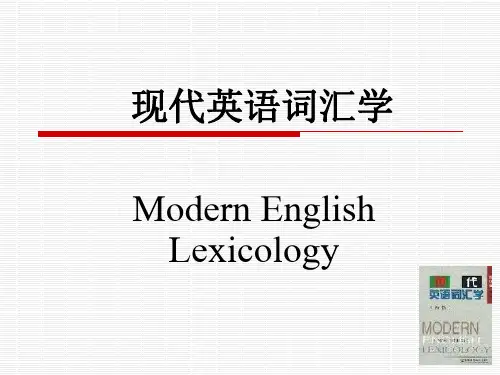
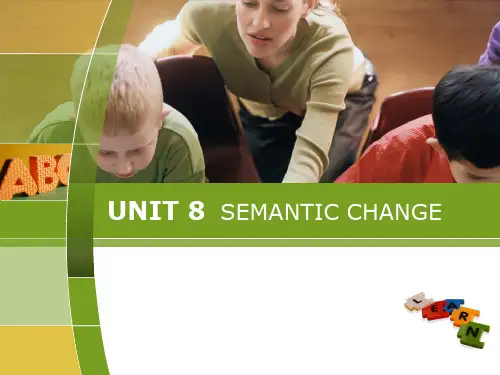
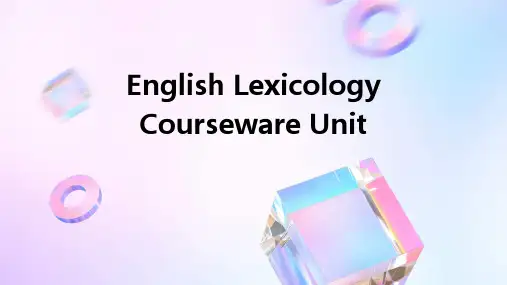
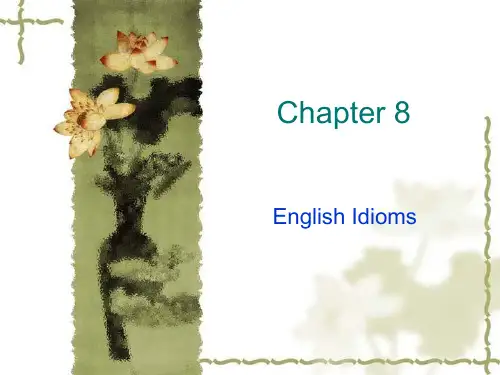
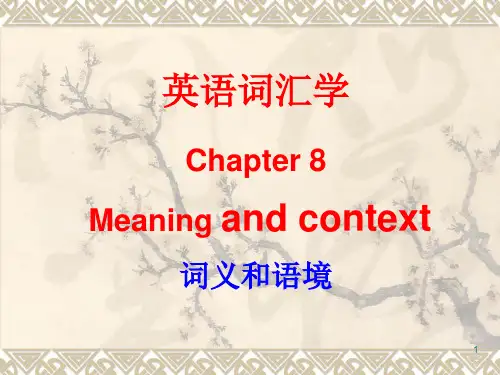
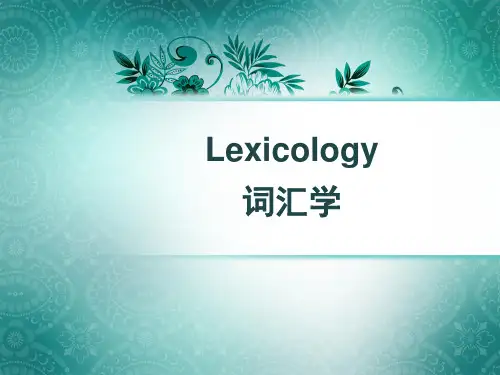
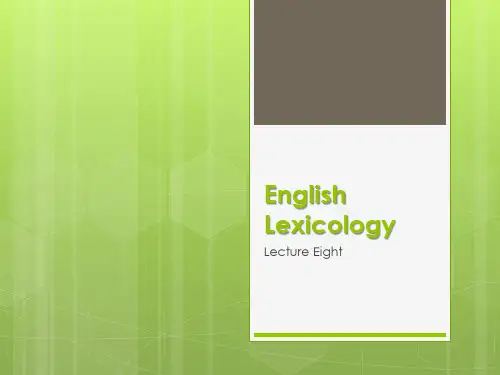
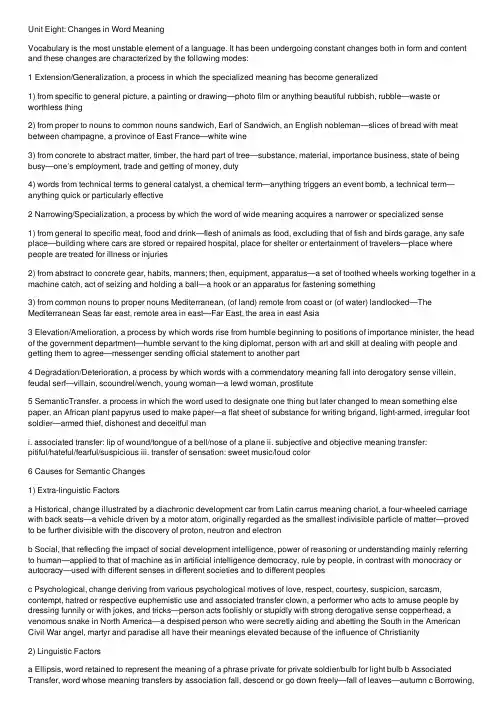
Unit Eight: Changes in Word MeaningVocabulary is the most unstable element of a language. It has been undergoing constant changes both in form and content and these changes are characterized by the following modes:1 Extension/Generalization, a process in which the specialized meaning has become generalized1) from specific to general picture, a painting or drawing—photo film or anything beautiful rubbish, rubble—waste or worthless thing2) from proper to nouns to common nouns sandwich, Earl of Sandwich, an English nobleman—slices of bread with meat between champagne, a province of East France—white wine3) from concrete to abstract matter, timber, the hard part of tree—substance, material, importance business, state of being busy—one’s employment, trade and getting of money, duty4) words from technical terms to general catalyst, a chemical term—anything triggers an event bomb, a technical term—anything quick or particularly effective2 Narrowing/Specialization, a process by which the word of wide meaning acquires a narrower or specialized sense1) from general to specific meat, food and drink—flesh of animals as food, excluding that of fish and birds garage, any safe place—building where cars are stored or repaired hospital, place for shelter or entertainment of travelers—place where people are treated for illness or injuries2) from abstract to concrete gear, habits, manners; then, equipment, apparatus—a set of toothed wheels working together in a machine catch, act of seizing and holding a ball—a hook or an apparatus for fastening something3) from common nouns to proper nouns Mediterranean, (of land) remote from coast or (of water) landlocked—The Mediterranean Seas far east, remote area in east—Far East, the area in east Asia3 Elevation/Amelioration, a process by which words rise from humble beginning to positions of importance minister, the head of the government department—humble servant to the king diplomat, person with art and skill at dealing with people and getting them to agree—messenger sending official statement to another part4 Degradation/Deterioration, a process by which words with a commendatory meaning fall into derogatory sense villein, feudal serf—villain, scoundrel/wench, young woman—a lewd woman, prostitute5 SemanticTransfer, a process in which the word used to designate one thing but later changed to mean something else paper, an African plant papyrus used to make paper—a flat sheet of substance for writing brigand, light-armed, irregular foot soldier—armed thief, dishonest and deceitful mani. associated transfer: lip of wound/tongue of a bell/nose of a plane ii. subjective and objective meaning transfer:pitiful/hateful/fearful/suspicious iii. transfer of sensation: sweet music/loud color6 Causes for Semantic Changes1) Extra-linguistic Factorsa Historical, change illustrated by a diachronic development car from Latin carrus meaning chariot, a four-wheeled carriage with back seats—a vehicle driven by a motor atom, originally regarded as the smallest indivisible particle of matter—proved to be further divisible with the discovery of proton, neutron and electronb Social, that reflecting the impact of social development intelligence, power of reasoning or understanding mainly referring to human—applied to that of machine as in artificial intelligence democracy, rule by people, in contrast with monocracy or autocracy—used with different senses in different societies and to different peoplesc Psychological, change deriving from various psychological motives of love, respect, courtesy, suspicion, sarcasm, contempt, hatred or respective euphemistic use and associated transfer clown, a performer who acts to amuse people by dressing funnily or with jokes, and tricks—person acts foolishly or stupidly with strong derogative sense copperhead, a venomous snake in North America—a despised person who were secretly aiding and abetting the South in the American Civil War angel, martyr and paradise all have their meanings elevated because of the influence of Christianity2) Linguistic Factorsa Ellipsis, word retained to represent the meaning of a phrase private for private soldier/bulb for light bulb b Associated Transfer, word whose meaning transfers by association fall, descend or go down freely—fall of leaves—autumnc Borrowing,word whose meaning changes because of borrowed words deer, formerly meaning animal—a large fast 4-footed animal, d Analogy, word whose meaning changes because of another word that is like it fortuitous, accidental of happening by chance —lucky, following fortunateUnit Nine: Semantic Changes from the Literal Use to Figurative UseParallel with the generalization and specialization of denotative meaning change and elevation and degeneration of connotative meaning change, another important semantic change is from literal to figurative1 Metaphor, a figure of speech which makes an implied comparison between two unlike elements without the connecting words of like or asImperialism is a paper tiger1) Anthropomorphic, comparison of inanimate objects to the parts of human bodyeye of needle/teeth of comb/lip of cup/mouth of river/nose of car/head of hammer/leg of table/foot of wall/arm of chair/hand of clock/ear of wheat/2) Animal, inanimate objects called after an animala dark horse, one who wins in a race out of expectation black sheep, one regarded with disfavor or shame as compared with others in a group3) Synaesthetic, a direct association between form and meaning of language based on similaritywarm and cold weather (literal)—warm and cold voice (metaphorical) a golden crown (literal)—a golden opportunity (metaphorical) a stormy day (literal)—a stormy quarrel (figurative)2 Simile, a figure of speech which makes a comparison between two unlike elements with at least one point of resemblance in appearance, quality, action or effect, using connecting word such as like or as He looks like his brother Food is important to people as water to fish3 Metonymy, a language device involving substitution of the name of one thing for that of another closely associated with it1) according to names of persons Uncle Sam, US government/John Bull, the English nation personified2) according to names of animals the Bear, the Soviet Union/the Dragon, Chinese3) according to names of parts of the body foot, infantry/mother tongue, native language/thumb of sth, the rule, principle of sth4) according to names of professions mass media, newspaper, magazine, TV and radio/bench, the judge5) according to location or building White House/Pentagon/Whitehall/Downing Street/Wall Street/Capitol Hill/Hollywood6) according to abstract words beauty, one who is very beautiful/7) according to the container for the thing bottle, wine/dish, food brought to table8) according to the material for the thing made board, a table where people sit around9) according to ellipsis a daily for daily paper/private for private soldier4 Synecdoche, a figure of speech involving the substitution of the part for the whole or the whole for the part1) the part for the whole We are no longer short of hands (helper) 2) the whole for the part Australia beat Canada in cricket. (the team)5 Euphemism, the substitution of a word with more pleasant connotation for the one with unpleasant connotationwash-room for toilet; lavatory/sanitation engineer for cleaner the call of nature for pass water; urinate or empty the bowels; go on stooluntidy for dirty/unwise for foolish/untruthful for lyingTo h with it for To hell with it/Why on earth not for Why the hell notdownturn for recession for depression for slump for economic crisisFor Reasons of Taboo, a custom of avoiding using certain expressions for religious, cultural or other social concernsIn western countries, people tend to avoid using religious words, thus they say:Goodness/My Goodness/Goodness me/For Goodness’ sake/Thank GoodnessBy Heaven/Good Heavens/Heaven forbid/Heaven knows/Gracious HeavenGracious me/My Gracious/Gracious/My Gum/By Gum6 Personification, a figure of speech in which something impersonal is incarnated with life to act and conductThe pot calls the kettle black/Action speaks louder than words Fire and water are good servants but bad masters7 Rhetorical FeaturesRhetoric refers to the art of speaking or writing by ways of arrangement of word and its sound so as to produce special effect1) Phonetic Manipulation, an arrangement of words with similar or same sound to produce a particular effecta alliteration, the appearance of the same sound in the first two words as in might and main/part and parcelb rhyme, the ends of the same sound in words as in kith and kin/fair and square/A little pot is soon hot2) Lexical Manipulation, the arrangement of words to produce a particular effecta reiteration, the duplication of synonyms pick and choose; select with much care/odds and ends; remnantsb repetition, the reuse of the same word in an expression all in all; totally/out and out; thoroughlyc juxtaposition, the placement of antonyms side by side hit or miss/treat or trick/rain or shine/sooner or laterd miscellaneous manipulation for syntactic effects as contrast/parallelismUnit Ten: Word Meaning and ContextContext of situation refers to the whole set of external world features considered to be relevant in the analysis of an utterance at different levels. It states the meaning of a word in terms of the speech in which it is used. There are following examples:A phatic communion, a speech situation in which the words do not express meaning but a purely social action as “How are you?”B language deictics, expression identifying objects, persons and events in terms of their relations to the speaker in space and time as a spatial relations of here and there/this and that/come and go/bring and take b time relations of now andthen/yesterday and tomorrow c social relations denoting politeness, familiarity or seriousness. They reflect the style of speech which mainly entail the following features4 " > a ) p r o v i n c e , c o n c e r n e d w i t h e x p r e s s i o n s o f o c c u p a t i o n o r p r o f e s s i o n a l a c t i v i t y b ) s t a t u s , r e l a t e d t o f o r m a l i t y a n d u s e o f p o l i t e a n d c o l l o q u i a l l a n g u a g e a p p r o p r i a t e f o r c o r r e s p o n d i n g s o c i a l o c c a s i o n s c ) m o d a l i t y , p e r t a i n e d t o t h e c h o i c e o f e x p r e s s i o n a p p l i c a b l e t o r e l e v a n t l a n g u a g e b o d y s u c h a s p o e t r y a n d p r o s e , e s s a y a n d s h o r t s t o r y , m e m o r a n d a , t e l e g r a m s o r j o k e s / p > p b d s f i d = " 1 15 " > T h e r e a r e t w o t y p e s o f c o n t e x t s : l i n g u i s t i c a n d e x t r a - l i n g u i s t i c . T h e f o r m e r i n c l u d e s l e x i c a l a n d g r a m m a t i c a l o n e s a n d t h e l a t t e r c o m p r i s e s t h a t o f s i t u a t i o n , c u l t u r e a n d s t y l e . / p > p b d s f i d = " 1 16 " > W o r d m e a n i n g v a r i e s a n d t h e v e r y s e n s e o f t h e w o r d i s d e t e r m i n e d b y t h e c o n t e x t / p > p b d s f i d = " 1 17 " > 1 E x t r a - l i n g u i s t i c w h i c h i n v o l v e s t h e s p e a k e r s i n t e n t i o n , t h e h e a r e r s i n t e r p r e t a t i o n a n d t h e o c c a s i o n o f t h e u t t e r a n c e .A n d i t m a y e m b r a c e t h e e n t i r e c u l t u r a l b a c k g r o u n d / p > p b d s f i d = " 1 1 8 " > 2 L i n g u i s t i c w h i c h c o m p r i s e s / p > p b d s f i d = " 1 1 9 " > 1 ) L e x i c a l , t h e s t a t e i n w h i c h o n e w o r d m e a n i n g i s a f f e c t e d a n d d e f i n e d b y t h e n e i g h b o r i n g w o r d s A s h e e t o f p a p e r / a w h i t e p a p e r / a t e r m p a p e r / e x a m i n a t i o n p a p e r / p > p b d s f i d = " 1 2 0 " > 2 ) G r a m m a t i c a l , t h e c a s e s i n w h i c h t h e m e a n i n g o f w o r d i s i n f l u e n c e d b y t h e s t r u c t u r e w h e r e t h e w o r d a p p e a r s T h i s s o r t o f b e h a v i o r s e l d o m b e c o m e s a p e r s o n i n y o u r p o s i t i o n ( s u i t ) W h a t w i l l b e c o m e o f y o u i f t h e c o m p a n y g o e s b a n k r u p t ? ( h a p p e n t o ) D a y d r e a m s h a v e b e c o m e r e a l i t i e s . ( t u r n i n t o ) / p > p b d s f i d = " 1 2 1 " > 3 T h e R o l e s o f C o n t e x t / p > p b d s f i d = " 1 2 2 " > 1 ) E l i m i n a t i o n o f A m b i g u i t y H e i s a h a r d b u s i n e s s m a n ( a m b i g u o u s ) H e i s a h a r d b u s i n e s s m a n t o d e a l w i t h I l i k e M a r r y b e t t e r t h a n J e a n ( a m b i g u o u s ) I l i k e M a r r y b e t t e r t h a n J e a n l i k e s M a r r y . I l i k e M a r r y b e t t e r t h a n I d o J e a n / p > p b d s f i d = " 1 2 3 " > 2 ) I n d i c a t i o n o f R e f e r e n t s I w a n t t o t e l l . ( a m b i g u o u s ) I w a n t t o t e l l t h i s t o h i m n o w h e r e . / p > p b d s f i d = " 1 2 4 " > 3 ) P r o v i s i o n o f C l u e s f o r I n t e r p r e t a t i o n / p > p b d s f i d = " 1 2 5 " > a d e f i n i t i o n : P e r h a p s t h e m o s t s t a r t l i n g t h e o r y t o c o m e o u t o f k i n e s i c s , t h e s t u d y o f b o d y m o v e m e n t , w a s s u g g e st e d b y D r . C o l e m a n / p > p b d s f i d = " 1 2 6 " > b e x p l a n a t i o n : I t s j u s t o n e m o r e i n c r e d i b l e r e s u l t o f t h e d e v e l o p m e n t o f m i c r o p r o c e s s o r s t h o s e t i n y p a r t s o f a c o m p u t e r c o m m o n l y k n o w n a s s i l i c o n c h i p s . / p > p b d s f i d = " 1 2 7 " > c e x a m p l e : M a n y U N e m p l o y e e s a r e p o l y g l o t s . M s . M a r y , f o r e x a m p l e , s p e a k s f i v e l a n g u a g e s / p > p b d s f i d = " 1 2 8 " > d s y n o n y m y : T h e i r g r e a t e s t f e a r w a s o f a c o n f l a g r a t i o n , s i n c e f i r e w o u l d d e s t r o y t h e i r f l i m s y w o o d e n s e t t l e m e n t b e f o r e h e l p c o u l d a r r i v e / p > p b d s f i d = " 1 2 9 " > e a n t o n y m y : A s t h e f i g h t i n g o n a l l f r o n t s r e a c h e d i t s p e a k , t h e e c o n o m y n e a r e d i t s n a d i r . / p > p b d s f i d = " 1 3 0 " > f h y p o n y m y : T h e v i l l a g e h a d t h e u s u a l a m e n i t i e s : a p u b , a l i b r a r y , a p o s t o f f i c e , a v i l l a g e h a l l , a m e d i c a l c e n t e r a n d a s c h o o l / p > p b d s f i d = " 1 3 1 " > g w o r d s t r u c t u r e : C o p e r n i c u s b e l i e v e d i n a h e l i o c e n t r i c u n i v e r s e , r a t h e r t h a n i n t h e g e o c e n t r i c t h e o r y . / p > p b d s f i d = " 1 3 2 " > h R e l e v a n t d e t a i l s : D o g e t m e a c l o p , s h e s a id , s m a c k i n g he r l i p s , b u t h e r b r o t h e r , w i t h a s c o r nf u lg l a n c e u p a t th e b r a n c h e s , s ai d t h a t t he r e w e r e n o n e r i p e y e t . / p > p b d sf i d = " 1 3 3 " > U n i t E l e v e n : E ng l i sh I di o m s . / p > p b d s f i d = " 1 34 " > I d i o m s c o n s i s t o f s e t p h r a s e s a n d s h o r t s e n t e n c e s , w h i c h a r e p e c u l i a r t o t h e l a n g u a g e i n d i s c u s s i o n a n d l o a d e d w i t h t h e n a t i v e c u l t u r e s a n d i d e a s . T h e r e f o r e , i d i o m s a r e c o l o r f u l , f o r c i b l e a n d t h o u g h t - p r o v o k i n g . T h e y a r e t h e e x p r e s s i o n s n o t r e a d i l y u n d e r s t a n d a b l e f r o m t h e i r l i t e r a l m e a n i n g s o f i n d i v i d u a l e l e m e n t s . I n a b r o a d s e n s e , i d i o m s i n c l u d e c o l l o q u i a l i s m s , c a t c h p h r a s e s , s l a n g e x p r e s s i o n s , p r o v e r b s , e t c . . / p > p b d s f i d = " 1 35 " > 1 C h a r a c t e r i s t i c s o f I d i o m s / p > p b d s f i d = " 1 36 " > 1 ) S e m a n t i c U n i t y : A n i d i o m m a y c o n s i s t o f m o r e t h a n o n e w o r d , b u t e a c h i s a s e m a n t i c u n i t y , w i t h t h e w o r d s i n v o l v e d l o s i n g t h e i r i n d i v i d u a l i d e n t i t y / p > p b d s f i d = " 1 37 " > 2 ) S t r u c t u r a l S t a b i l i t y : U n l i k e t h a t o f f r e e p h r a s e s , t h e s t r u c t u r e o f a n i d i o m t o a l a r g e e x t e n t i s u n c h a n g e a b l e . T h e w o r d o r d e r c a n n o t b e i n v e r t e d n o r w o r d r e p l a c e d ; t h e c o n s t i t u e n t s c a n n o t b e d e l e t e d o r a d d e d t o ; a n d m a n y i d i o m s a r e g r a m m a t i c a l l y u n a n a l y s a b l e T h e i d i o m a t i c i t y o f e x p r e s s i o n s i s g r a d a b l e o n a s c a l e w i t h f o r m s o f t r u e i d i o m s , s e m i - i d i o m s a n d f r e e p h r a s e s . / p > p b d s f i d = " 1 38 " > 2 C r i t e r i a o n I d i o m s / p > p b d s f i d = " 1 39 " > 1 ) S h i f t / S p l i t T e s t: T h e m a c h i n e t u r n s o n t h e c e n t r a l p i v o t ( r o t a t e ) P o p m u s i c t u r n s m a n y p e o p l e o n ( e x c i t e ) i d i o m a t i c / p > p b d s f i d = " 1 4 0 " > 2 ) P a r t i c l e D e l e t i o n T e s t : R o b e r t d r e w o u t 2 0 p o u n d s f r o m h i s s a v i n g s a c c o u n t ( w i t h d r a w ) H i s p r o m o t i o n s t e p p e d u p h i s s o c i a l s t a t u s ( e l e v a t e ) i d i o m a t i c / p > p b d s f i d = " 1 4 1 " > 3 ) R e p l a c e m e n t T e s t : T h e w e a t h e r r e a l l y m u c k e d u p o u r w e e k e n d ( m e s s u p ) O n e s h o u l d n e v e r t u r n s u p h i s n o s e a t a n y o n e h e d i s l i k e s . ( s h o w d i s d a i n f o r ) i d i o m a t i c / p > p b d s f i d = " 1 4 2 " > 3 C l a s s i f i c a t i o n o f I d i o m s / p > p b d s f i d = "1 4 3 " > I n t e r m s o f s t r u c t u r e , i d i o m s f a l l i n t o t h e f o l l o w i n g c a t e g o r i e s : 1 ) L e x e m i c I d i o m s ; t h o s e f o r m e d a r o u n d m a i n w o r d s a s l i k e t h e b r e e z e m e a n i n g e a s i l y2 ) P h r a s e o l o g i c a l I d i o m s ; t h o s e c o m i n g i n t o a n e n t i r e c l a u s e s i n l e n g t h a s f l y o f f t h e h a n d l e m e a n i n g l o s e c o n t r o l o f o n e s e l f3 ) S e n t e n c e I d i o m s ; t h o s e e s t a b l i s h e d p o p u l a r s a y i n g s a n d p r o v e r b s a s A l l i s n o t g o l d t h a t g l i t t e r s / p > p b d s f i d = " 14 4 " > S t y l i s t i c a l l y , i d i o m s t a k e t h e f o r m s o f t h e f o l l o w i n g : / p > p b d s f i d = " 1 45 " > 1 ) c o l l o q u i a l i s m , a f a m i l i a r , i n f o r m a l w a y o f c o n v e r s a t i o n a s h a n g i n m e a n i n g n o t g i v e u p 2 ) s l a n g , a k i n d o f e x p r e s s i o n n o t a c c e p t a b l e i n s e r i o u s s p e e c h a s b u c k f o r d o l l a r / p > p b d s f i d = " 1 46 " > 3 ) l i t e r a r y e x p r e s s i o n , a f o r m o f l a n g u a g e n o t u s e d i n o r d i n a r y o c c a s i o n b u t f o r t h e l i t e r a c y i n t h e f o r m a l s t a t e m e n t a s b e i t t h a t m e a n i n g e v e n t h o u g h / p > p b d s f i d = " 1 47 " > F o r r h e t o r i c a l p u r p o s e s , i d i o m s a p p e a l i n t h e f o l l o w i n g w a y s : / p > p b d s f i d = " 1 48 " > 1 ) p h o n e t i c m a n i p u l a t i o n a a l l i t e r a t i o n a s n e i t h e r f i s h , f l e s h , n o r f o w l m e a n i n g d i f f i c u l t t o c l a s s i f y b r h y m e a s f a i r a n d s q u a r e m e a n i n g j u s t o r h o n e s t / p > p b d s f i d = " 1 49 " > 2 ) l e x i c a l m a n i p u l a t i o n a r e i t e r a t i o n a s b i t s a n d p i e c e s m e a n i n g o d d s a n d e n d s b r e p e t i t i o n a s b y a n d b y m e a n i n g g r a d u a l l y c j u x t a p o s i t i o n a s r a i n o r s h i n e m e a n i n g u n d e r a l l c o n d i t i o n / p > p b d s f i d = " 1 5 0 " > A c c o r d i n g t o f i g u r a t i v e s p e e c h , i d i o m s t a k e t h e f o l l o w i n g f o r m s / p > p b d s f i d = " 1 5 1 " > 1 ) s i m i l e a s e a t l i k e a h o r s e m e a n i n g h u n g r i l y 2 ) m e t a p h o r a s c r o c o d i l e t e a r s m e a n i n g s h o w i n s i n c e r e s o r r o w 3 ) m e t o n y m y , a s m a k e u p o n e s p u r s e m e a n i n g r a i s e m o n e y 4 ) s y n e c d o c h e a s e a r n o n e s b r e a d m e a n i n g m a k e a l i v i n g 5 ) p e r s o n i f i c a t i o n a s A c t i o n s p ea k s l o u d e r t h a n w o r d s 6 ) e u p h e m i s m a s p e r f u m e d t a l k m e a n i n g i n d e c e n t t a l k / p > pb d s f i d = "1 52 " > U n i t T w e l v e : E n g l i s h D i c t i o n a r y / p > p b d s f i d = " 1 53 " > A d i c t i o n a r y i s a r e f e r e n c e b o o k c o n t a i n i n g w o r d s u s u a l l y a l p h a b e t i c a l l y a r r a n g e d a l o n g w i t h i n f o r m a t i o n a b o u t t h e i r f o r m s , p r o n u n c i a t i o n s , f u n c t i o n s , e t y m o l o g i e s , m e a n i n g s a n d s y n t a c t i c a l a n d i d i o m a t i c u s e s . / p > p b d s f i d = " 1 54 " > 1 T y p e s o f D i c t i o n a r i e s / p > p b d s f i d = " 15 5 " > 1 ) m o n o l i n g u a l , b i l i n g u a l a n d m u l t i - l i n g u a l 2 ) l i n g u i s t i c a n d e n c y c l o p e d i c ; o n e d e f i n e s w o r d s a n d t h e o t h e r e x p l a i n s f a c t s a n d c o n c e p t s 3 ) u n a b r i d g e d , d e s k a n d p o c k e t 4 ) g e n e r a l a n d s p e c i a l i z e d / s u b j e c t 5 ) s y n c h r o n i c a n d d i a c h r o n i c6 ) p r i n t e d a n d e l e c t r o n i c / p > p b d s f i d = " 1 5 6 " > 2 T h e H i s t o r y o f E n g l i s h D i c t i o n a r i e s / p > p b d s f i d = " 1 57 " > T h e h i s t o r y o f E n g l i s h d i c t i o n a r y b e g a n w i t h g l o s s a r i e s i n t h e M i d d l e E n g l i s h p e r i o d a n d h a v e u n d e r g o n e f i v e p e r i o d s / p > p b d s f i d = " 1 58 " > 1 ) M i d d l e A g e s - e n d o f 1 6 t h c e n t u r y , g l o s s a r y - m a k i n g ; T h o m a s C o o p e r s T h e s a u r u s L i n g u a e R o m a n a e o f B r i t a n n i c a e o f 1 5 6 5 / p > p b d s f i d = " 1 59 " > 2 ) B e g i n n i n g o f 1 7 t h c e n t u r y , h a r d w o r d s d e a l i n g ; R o b e r t C a w d r e y s A T a b l e o f A l p h a b e t i c a l E n g l i s h W o r d s o f 1 6 0 4 / p > p b d s f i d = " 1 6 0 " > 3 ) M i d d l e - e n d o f 1 7 t h c e n t u r y , e t y m o l o g i c a l s t u d y ; S t e p h e n S k i n n e r sE t y m o l o g i c a l L i n g u a e A n g l i c a n a e o f 1 6 6 7 / p > p b d s f i d = " 1 6 1 " > 4 ) 1 8 t h c e n t u r y , s t a n d a r d i z a t i o n ; S a m u e l J o h n s o n s A D i c t i o n a r y o f t h e E n g l i s h L a n g u a g e o f 1 7 5 5 / p > p b d s f i d = " 1 6 2 " > 5 ) 1 9 t h - 2 0 t h c e n t u r y , i m p r o v e m e n t a n d m a t u r i t y ; / p > p b d s f i d = " 1 6 3 " > a . C h a r l e s R i c h a r d s o n s A N e w D i c t i o n a r y o f t h e E n g l i s h L a n g u a g e o f 1 8 3 6 b . T h e O x f o r d E n g l i s h D i c t i o n a r y o f 1 9 2 8 c . T h e C o n c i s e O x f o r d D i c t i o n a r y o f 1 9 1 1 d . N o a h W e b s t e r s T h e A m e r i c a n D i c t i o n a r y o f t h e E n g l i s h L a n g u a g e o f 1 8 2 8 e . W e b s t e r s T h i r d N e w I n t e r n a t i o n a l D i c t i o n a r y o f t h e E n g l i s h L a n g u a g e o f 1 9 6 1 / p > p b d s f i d = " 1 6 4 " > 3 C o n t e n t o f t h e D i c t i o n a r y / p > p b d s f i d = " 1 6 5 " > 1 ) s p e l l i n g i n c l u d e s s t a n d a r d f o r m , a l t e r n a t i v e s a n d v a r i a n t s ; i r r e g u l a r v e r b s ; f o r m s o f c o m p o u n d - - - s o l i d , h y p h e n a t e d a n d o p e n ; s y l l a b i c a t i o n o f w o r d s ; a n d c a p i t a l i z a t i o n / p > p b d s f i d = " 1 6 6 " > 2 ) p r o n u n c i a t i o n : B r i t i s h d i c t i o n a r i e s g e n e r a l l y u s e I n t e r n a t i o n a l P h o n e t i c A l p h a b e t a n d A m e r i c a n o n e s e m p l o y W e b s t e r s s y s t e m s / p > p b d s f i d = " 1 6 7 " > 3 ) d e f i n i t i o n , t h e m a i n b o d y o f d i c t i o n a r y i n w h i c h p o l y s e m a n t s a r e l i s t e d c h r o n i c a l l y w i t h e a r l y m e a n i n g c o m i n g i n f i r s t , a n d p r i n c i p a l l y l i t e r a l u s e a r r a n g e d b e f o r e f i g u r a t i v e , g e n e r a l b e f o r e s p e c i a l , c o m m o n b e f o r e r a r e . T h e a p p r o a c h t o d e f i n i t i o n m a y t a k e t h e f o r m s o f e x p l a n a t i o n s , s y n o n y m s , i l l u s t r a t i v e s e n t e n c e s a n d e v e n a i d i n g p i c t u r e s / p > p b d s f i d = " 1 6 8 " > 4 ) u s a g e c o m p r i s e s u s a g e l e v e l : s t a n d a r d , s u b s t a n d a r d , n o n - s t a n d a r d , i l l i t e r a t e ; s t y l e : f o r m a l , i n f o r m a l , c o l l o q u i a l , s l a n g , b i b l i c a l , p o e t i c ; c u r r e n c y : o l d - f a s h i o n e d , a r c h a i c , o b s o l e t e ; r e g i s t e r : l a w , c h e m i s t r y , m e d i c i n e , B r E , A m E ; c o l o r i n g : a p p r e c i a t i v e , d e r o g a t o r y , e u p h e m i s m , h u m o r , p o m p o u s / p > p b d s f i d = " 1 6 9 " > 5 ) g r a m m a r c o v e r s w o r d c l a s s e s , i n f l e c t i o n s a n d s y s t e m o f v e r b p a t t e r n s / p > p b d s f i d = " 1 7 0 " > 6 ) u s a g e n o t e s a n d l a n g u a g e n o t e s U s a g e n o t e s e x p l a i n t h e s l i g h t d i f f e r e n c e s b e t w e e n w o r d s o f s i m i l a r m e a n i n g s ; d i f f i c u l t p o i n t s o f g r a m m a r / p > / d i v > / d i v > d i v c l a s s = " m o r e - b o e " b d s f i d = " 1 7 1 " > d i v c l a s s = " r e a d _ m o r e _ m a s k " b d s f i d = " 1 7 2 " > / d i v >。
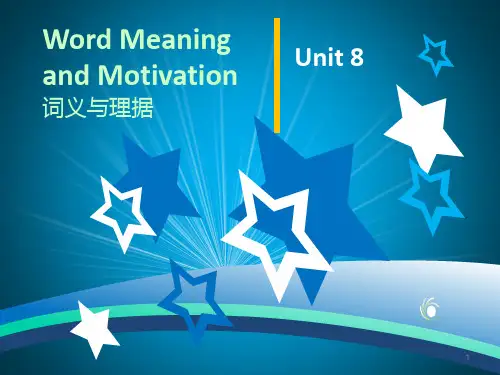
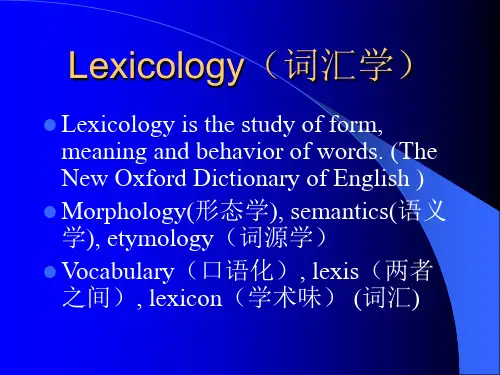
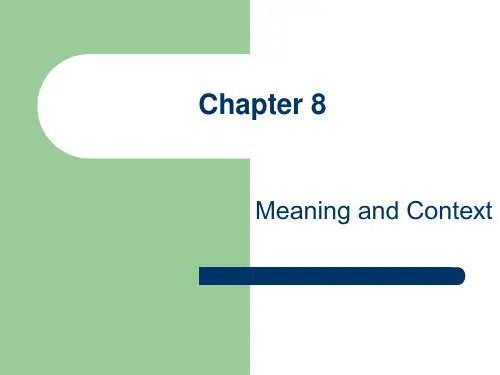
张维友英语词汇学教程第八章课本词汇,又称语汇,是一种语言里所有的(或特定范围的)词和固定短语的总和。
词汇是构建语言的材料,学好词汇是学好英语的关键。
词汇教学一直是英语教学中令教师最为头痛的一个难题。
为帮助教师搞好词汇教学,下面介绍几种词汇教学方法。
利用标音规则教学单词英语属于拼音文字,拼读和拼写是密不可分的,它们之间的联系就是规则。
拼读规则是学习英语的拐杖,是学生认读词汇的金钥匙。
教师应帮助学生通过大量的拼读练习,发现和掌握元音字母和辅音字母在单词中的读音规律,常见字母组合的拼读规则,使学生按有关规律和规则推断单词的读音。
反之,从单词的读音可判断其拼写形式,养成见到单词会读音、听到语音会写词的能力。
在语境中教学单词词语要放在语境中才有生命,才容易记住,才知道用法。
如果没有一定的语境,任何词汇将变得没有意义。
语境包括句子、语篇和上下文。
如:教water这个词,呈现以下的句子。
i’m very thirsty. i want to drink some water. 2、the flowers are dry.i must water them everyday. 从语境中使学生知道第1句中的water是名词“水”,第2句中的是动词“浇水”的意思,从而掌握water 不同的词性和用法。
用构词法教学单词英语主要有三种构词法:转变,即为由一个词类转变为另一个词类。
比如:water 水(名词)―― water 浇水(动词)train火车 (名词) _____ train训练 (动词)open 开(动词) _____ open开着的(形容词)衍生,即为词根加前缀或后缀形成另一个词。
比如:(1)happy――unhappy ―― happiness(2)possible―― impossiblelike____ dislike3、合成,即由两个或更多的词合成一个词。
例如:(1) suit+case= suitcase(2)good +looking= good-looking(3)out+side= outsidein+side= inside(4)make+up= makeup(化妆品)四、用联想法教学单词M18x法就是所指从崭新单词与段小宇的单词之间的联系抓起,将词汇按一定的关系放到一起,同时记忆。